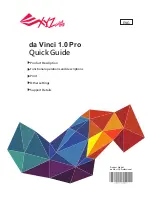
M
M
M
E
E
E
R
R
R
C
C
C
U
U
U
R
R
R
Y
Y
Y
U
U
U
S
S
S
E
E
E
R
R
R
M
M
M
A
A
A
N
N
N
U
U
U
A
A
A
L
L
L
47
A. Choose Printing Mode
A-1 B/W (Black & White) Mode
It is useful to activate this mode when using clip art or drawings with several colors, shades of
gray, or many outlines. This mode will create a laser output similar to that of a laser printer. The
entire selected image will be engraved using a single pen, black one (power & speed setting).
The Mercury driver will interpret colored and shaded areas as different shades of gray /
halftone areas, and it is a collection of dots. The resolution and depth of these halftone areas
can be adjusted with the DPI, the B/W mode dithering settings from 2x2 to 8x8, error diffusion,
and different pattern types Experiment with these different settings to get the optimal results for
your application.
Dithering type – The gray areas of image will be filled with different dot/ grid
density from a 5- grade halftone with 2x2 dots to a 65- grade halftone with 8x8
dots. 8x8 dithering type would presents the image into shading effect with more
dots than the 2x2 dithering, while the 2x2 dithering type would have smaller dots
than 8x8, that produces higher resolution. The dithering type choice would
depend on the image and application.
Enhance dithering – The enhance dithering as what it reads would help to
compensate the shortage of smaller grade halftone type, such as choosing 2x2
dithering type and enhance dithering at the same time, the image would be
printed with 256- grade halftone and 2x2 dots, therefore, better shading effect
with small 2x2 dots/ grids.
Error Diffusion – The error diffusion presents the shade of image as a spread
halftone instead of dots, therefore more detailed.
Pattern
Type
-
The halftone pattern has three kinds of layout options, which
determine the shape of each grid/ dot to compose the shading effect of raster
image.
















































